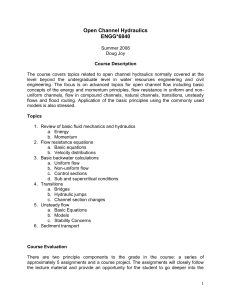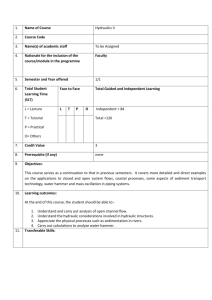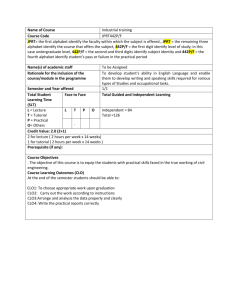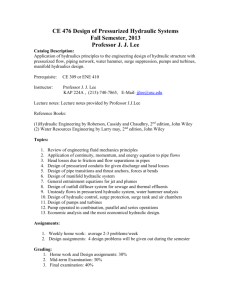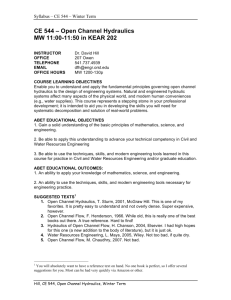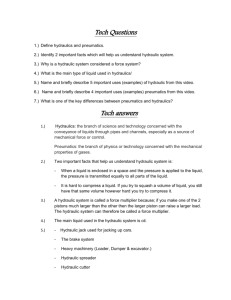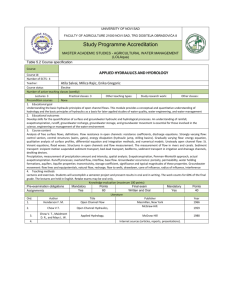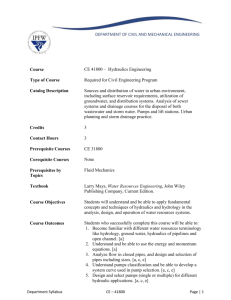Name of Course Hydraulics Course Code JHYR2193 JHYR= the
advertisement
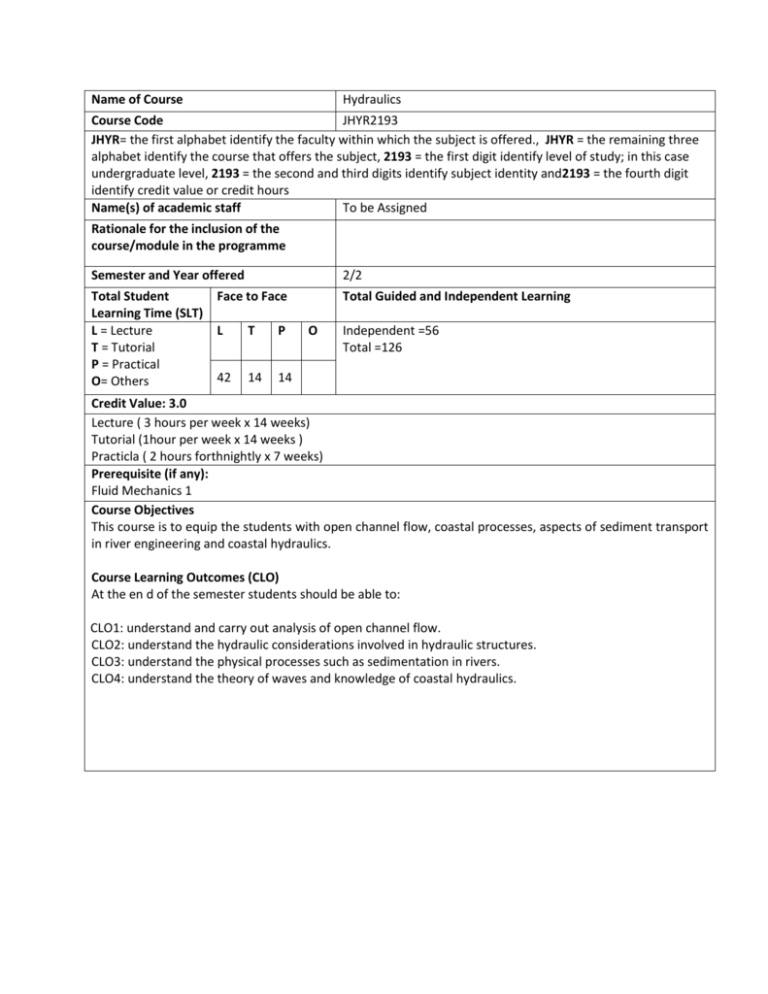
Name of Course Hydraulics Course Code JHYR2193 JHYR= the first alphabet identify the faculty within which the subject is offered., JHYR = the remaining three alphabet identify the course that offers the subject, 2193 = the first digit identify level of study; in this case undergraduate level, 2193 = the second and third digits identify subject identity and2193 = the fourth digit identify credit value or credit hours Name(s) of academic staff To be Assigned Rationale for the inclusion of the course/module in the programme Semester and Year offered 2/2 Total Student Face to Face Learning Time (SLT) L = Lecture L T P T = Tutorial P = Practical 42 14 14 O= Others Total Guided and Independent Learning O Independent =56 Total =126 Credit Value: 3.0 Lecture ( 3 hours per week x 14 weeks) Tutorial (1hour per week x 14 weeks ) Practicla ( 2 hours forthnightly x 7 weeks) Prerequisite (if any): Fluid Mechanics 1 Course Objectives This course is to equip the students with open channel flow, coastal processes, aspects of sediment transport in river engineering and coastal hydraulics. Course Learning Outcomes (CLO) At the en d of the semester students should be able to: CLO1: understand and carry out analysis of open channel flow. CLO2: understand the hydraulic considerations involved in hydraulic structures. CLO3: understand the physical processes such as sedimentation in rivers. CLO4: understand the theory of waves and knowledge of coastal hydraulics. Transferable Skills: This course is expected the development of the following transferable skills: a) Self-management – an ability to manage time and task b) Learning skills An ability to learn both independently and co—operatively; An ability to use library skills, to find and organize information ; An ability to use a wide range of academic skills (research, analysis, synthesis etc.); An ability to identify and evaluate personal learning strategies. c) Teamwork An ability to take responsibility and carry out agreed task; An ability to take initiative and lead other; An ability to identify and evaluate personal learning strategy. d) Problem solving An ability to analyse; An ability to think laterally about a problem; An ability to identify strategy options; An ability to solve the problems e) Information technologies An ability to use specialist software where relevant to the discipline. Teaching-learning and assessment strategy Teaching and Learning strategy Formal Lectures will provide theoretical underpinning for CLO1, 2, 3 and.4. Tutorials will enable calculations to support CLO1, 2, 3 and 4. Formal revision will be conducted during week 14 to prepare student for examination. Assessment Schedule and strategy 1. Assessment strategy: Assignment will enable CLO1 to be demonstrated. Quizzes will enable CLO2 to be demonstrated. Midterm Exam will enable CLO3 to be demonstrated. A three Hours Examination will assess CLO4 and 5 2. Assessment: Assignment 10% Tutorials 5% Quizzes 5% Midterm Exam 20% Final Exam 60% Total 100% Synopsis: This course deals with geotechnical principles related to stability of soil and rock slopes, design of reinforced earth structure, cellular cofferdam, shallow and deep foundation and techniques of improving problematic ground condition. Mode of Delivery: Lectures, tutorials and practicals. Assessment Methods and Types: Performance Criteria : CLO-PLO Assessment 1 Tool Marks Grade A CLO1: Understand and carry out analysis of open channel flow. 0-39 (F) Fail to: Learn both independent and cooperatively Use library skills, to find and organize information Use wide range of academic skills (research, analysis, synthesis etc.) 2 3 4 5 40-49 (D,D+) Poor to: Learn both independent and cooperatively Use library skills, to find and organize information Use wide range of academic skills (research, analysis, synthesis etc.) 50-59 (C-,C,C+) Satisfactory to: Learn both independent and cooperatively Use library skills, to find and organize information Use wide range of academic skills (research, analysis, synthesis etc.) 60-74 (B-,B,B+) Good to: Learn both independent and cooperatively Use library skills, to find and organize information Use wide range of academic skills (research, analysis, synthesis etc.) 75-100 (A-,A,A+) Excellent to: To: Learn both independent and cooperatively Use library skills, to find and organize information Use wide range of academic skills (research, analysis, synthesis etc.) Assessment Methods and Types: Performance Criteria : CLO-PLO Assessment 1 Tool Marks Grade CLO2: understand the hydraulic considerations involved in hydraulic structures T1 0-39 (F) Fail to: analyse the determinacy of the structure and apply the equation of equilibrium in order to determine the support and reactions and internal forces. Assessment Methods and Types: Performance Criteria : CLO-PLO Assessment 1 Tool Marks Grade T2 CLO3: understand the physical processes such as sedimentation in rivers. . 0-39 (F) Fail to: analyse the internal forces of a structure and draw the SFD & BMD 2 3 4 5 40-49 (D,D+) Poor to: analyse the determinacy of the structure and apply the equation of equilibrium in order to determine the support and reactions and internal forces. 50-59 (C-,C,C+) Satisfactory to: analyse the determinacy of the structure and apply the equation of equilibrium in order to determine the support and reactions and internal forces. 60-74 (B-,B,B+) Good to: analyse the determinacy of the structure and apply the equation of equilibrium in order to determine the support and reactions and internal forces. 75-100 (A-,A,A+) Excellent to: analyse the determinacy of the structure and apply the equation of equilibrium in order to determine the support and reactions and internal forces. 2 3 4 5 40-49 (D,D+) Poor to: analyse the internal forces of a structure and draw the SFD & BMD 50-59 (C-,C,C+) Satisfactory to: analyse the internal forces of a structure and draw the SFD & BMD 60-74 (B-,B,B+) Good to: analyse the internal forces of a structure and draw the SFD & BMD 75-100 (A-,A,A+) Excellent to: analyse the internal forces of a structure and draw the SFD & BMD Assessment Methods and Types: Performance Criteria : CLO-PLO Assessment 1 Tool Marks Grade E CLO4: Understand the theory of waves and knowledge of coastal hydraulics. 0-39 (F) Fail to: construct the II, and make use of the II. 2 3 4 5 40-49 (D,D+) Poor to: Construct the II, and make use of the II. 50-59 (C-,C,C+) Satisfactory to: construct the II, and make use of the II. 60-74 (B-,B,B+) Good to: construct the II, and make use of the II. 75-100 (A-,A,A+) Excellent to: construct the II, and make use of the II. Programme Learning Outcomes (PLO) Programme Objectives (PO) proficient knowledge and competency in various areas in Civil/Electrical/Mechanical Engineering professional, generic attributes to meet the present and future global demands. Islamic humanistic values and reinvention skills to meet the requirement of a dynamic environment. These skills include Civil Intelligence, Moral Intelligence, Self-Reliance and Communication Skills PEO2: To produce graduates with PLO11: ability to become Entrepreneur; PLO10: Recognising the need to undertake lifelong learning, and possessing /acquiring the capacity to do so; PEO1: To produce graduates with PLO9: Ability to function effectively in group with the capacity to be a leader or manager; PLO8: ability to function effectively as an individual; PLO7: Ability to communicate effectively, not only with engineers but also with the community at large; PLO5: Understanding of the principles of design for sustainable development; PLO6: Understanding of professional ethics, Islamic values, social, cultural, global and environmental responsibilities of a professional engineer and commitment to them; PLO3: Ability to undertake problem identification, formulation and solution; PLO4: Ability to utilise systems approach to design and evaluate operational performance; PLO2: Acquired in‐depth technical competence in civil engineering discipline; PLO1: Ability to acquire and apply knowledge of science and engineering fundamentals; 15. 1. Mapping of the Programme Objectives to the Programme Learning Outcomes PEO3: To produce graduates with CLO1: understand and carry out analysis of open channel flow. PLO11 PLO10 PLO9 PLO8 PLO7 PLO6 PLO5 PLO4 PLO3 Programme Learning Outcomes (PLO) Course Learning Outcome (CLO) PLO2 Mapping of the course Learning Outcome to the Programme Outcome PLO1 16. Delivery Methods Lecture Tutorial Practical Assessme nt Methods Assignme nt Test1 Examinat ion CLO2: understand the hydraulic considerations involved in hydraulic structures. CLO3: understand the physical processes such as sedimentation in rivers. Lecture Tutorial Practical Test 2 Examinat ion CLO4: understand the theory of waves and knowledge of coastal hydraulics. Lecture Tutorial Practical Test3 Lecture Tutorial Practical Test1 Examinat ion Examinat ion SLT Topic 17. Topic 1 Topic 2 Topic 3 Topic 4 Topic 5 Introduction Introduction to hydraulics and its application in civil engineering. Open channel flow. Uniform flow in open channels. Calculating velocity and discharge using Chezy, Bazin and Manning formulas for different types of cross-sections and optimum cross sections. Non-uniform flow in open channels. Steady flow, gradually varied flow and rapidly varied flow.Surface profile classification. Concept of specific energy and alternate depths. Critical depth in rectangular channels. Froude number. Critical, subcritical and supercritical flows. Critical depths in nonrectangular channels. Occurrences of critical flow conditions. Effect of change in bed level - flow over broad crested weir. Effect of lateral contraction of a channel-Venturi flume. Hydraulic jumps – classification and location Hydraulic structures dams spillways outlet works and stilling basins River engineering and sedimentation Engineering process, bed materials transport, suspended sediment transport and sediment transport Equations (bed load, suspended load and total load), threshold of movement Entrainment function sediment measurement, sediment yield of water shed sediment simulation reservoir sedimentation River forms - meanders, river training and regime theory. L T P IS Total 3 1 4 8 12 4 16 32 6 2 8 16 12 4 16 32 3 12 24 Waves and coastal hydraulics Theory of deep sea and shallow water waves Wave forces on structures Solitary and Cnoidal waves Stokes general equation for waves. 9 Reflection and refraction processes. Local fluid velocities and accelerations in shallow and deep sea conditions. Local fluid displacements in shallow and deep sea conditions. Practicals Flow through rectangular open channel v-notch 14 18. 19. Determination of critical depth in open channel flow Flow over sharp crested weir 14 Total Hour 42 14 14 56 126 Main references supporting the course 1. Open-Channel Flow by M. Hanif Chaudhry (Dec 4, 2007) 2. Fundamentals of Hydraulic Engineering Systems (4th Edition) by Robert J. Houghtalen, A. Osman Akan and Ned H. C. Hwang (Aug 17, 2009) 3. Water Resources Engineering by Larry W. Mays (Jun 8, 2010) 4. Civil Engineering Hydraulics by C. Nalluri (Jul 21, 2009) Additional references supporting the course 1. K. Subramanya - Flow in Open Channels. Tata McGraw Hill Publishing Company Limited, 1979, Second Edition. 2. Ned H.C. Hwang, Robert J. Houghtalen - Fundamentals of Hydraulic Engineering Systems, Third Edition, Prentice Hall, 1996. 3. Charles Jaeger - Fluid Transients in Hydro-Electric Engineering Practice, Blackie & Son Limited, 1977. 4. Roberson Cassidy, Chaudhry - Hydraulic Engineering, Second Edition, 1997, John Wiley & Sons. 5. Post-Graduate Course in Sediment Transport Technology Proceedings, volume 1 & 2, 1994, Turkey. 6. B.B. Sharp - Waterhammer - Problems and Solutions, 1981, Edward Arnold. Other additional information All materials will be available to the students in the library.

